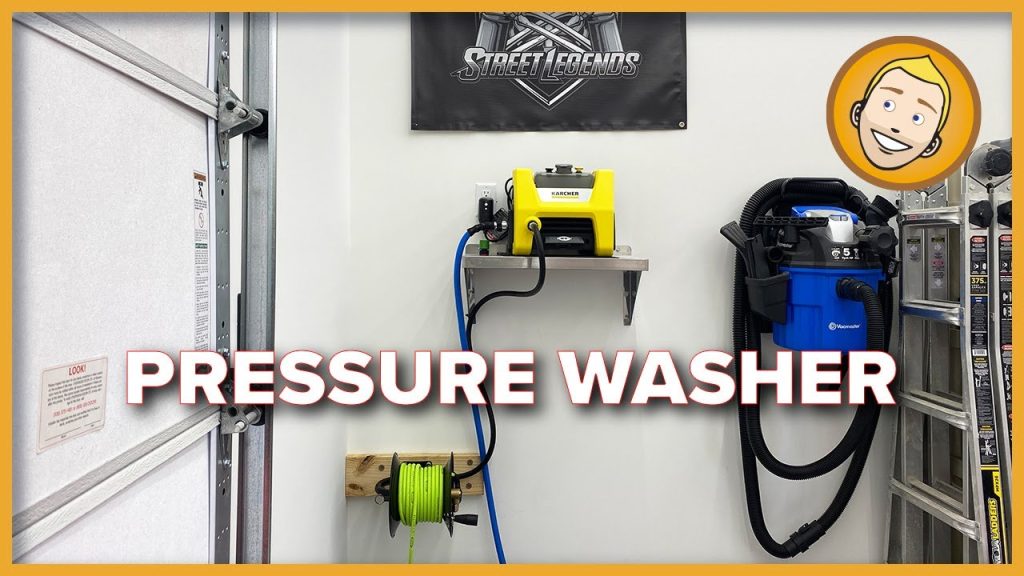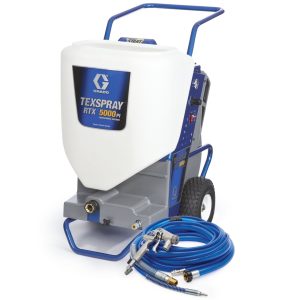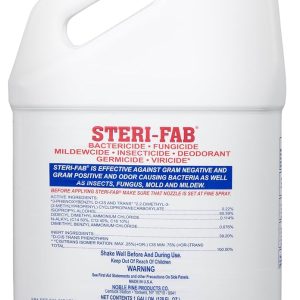
What Is a Pressure Washer Reel and Why You Need One
A pressure washer reel represents one of the most practical investments you can make for your cleaning equipment setup. These specialized storage systems are designed to neatly wind and store your pressure washer hose, protecting it from damage while keeping your workspace organized and safe. Unlike traditional hose storage methods that often result in tangled, kinked, or damaged hoses, pressure washer reels provide a systematic solution that extends equipment life and improves operational efficiency.
The primary function of a pressure washer reel extends beyond simple storage. These systems protect your expensive high-pressure hoses from UV damage, extreme temperatures, and physical wear that occurs when hoses are left on the ground or improperly stored. Professional cleaning contractors and homeowners alike have discovered that investing in a quality pressure washer reel system can significantly reduce hose replacement costs while improving overall cleaning productivity.
Modern pressure washer reels come equipped with various features including swivel connections, adjustable mounting brackets, and different winding mechanisms. The engineering behind these systems focuses on handling the unique challenges of high-pressure hoses, which are typically heavier and more rigid than standard garden hoses. This specialized design ensures smooth operation even under demanding commercial cleaning conditions.
Types of Pressure Washer Reel Systems Available
Manual Pressure Washer Reels
Manual pressure washer reel systems represent the most common and cost-effective option for both residential and commercial applications. These hand-crank systems require physical effort to wind and unwind the hose but offer several distinct advantages. Manual reels typically feature robust construction with fewer moving parts, resulting in lower maintenance requirements and increased reliability over time.
The operation of manual pressure washer reels involves a simple crank mechanism that allows users to control the winding speed and tension. This manual control proves particularly beneficial when working with different hose lengths or when precise hose positioning is required. Professional cleaning contractors often prefer manual systems because they provide better control during setup and breakdown procedures.
Key Benefits of Manual Systems:
- Lower initial cost compared to automatic alternatives
- Reduced mechanical complexity means fewer failure points
- Better control over winding speed and hose positioning
- Suitable for various hose lengths and pressure ratings
- Easy maintenance with simple lubrication requirements
Automatic Pressure Washer Reels
Automatic pressure washer reel systems utilize spring-loaded or motor-driven mechanisms to retract hoses with minimal user effort. These advanced systems represent the premium end of the market and are particularly popular in commercial applications where efficiency and speed are critical factors. The automatic retraction feature significantly reduces setup and breakdown time, making them ideal for busy cleaning operations.
Spring-loaded automatic reels use a constant tension spring mechanism that provides steady retraction force throughout the hose length. Motor-driven systems, on the other hand, utilize electric or pneumatic motors to control hose retraction, offering even greater convenience and control options. Both types typically include safety features such as controlled retraction speed and automatic stop mechanisms.
Advantages of Automatic Systems:
- Effortless operation reduces physical strain on operators
- Faster setup and breakdown improves operational efficiency
- Consistent hose storage prevents tangling and damage
- Professional appearance enhances business image
- Safety features prevent rapid hose retraction accidents
Choosing the Right Pressure Washer Reel for Your Needs
Hose Length and Diameter Considerations
Selecting the appropriate pressure washer reel requires careful consideration of your specific hose requirements. Hose length directly impacts the size and type of reel needed, with longer hoses requiring larger drum diameters and more robust mounting systems. Standard residential applications typically use 50-100 foot hoses, while commercial operations may require 150-300 foot lengths or more.
Hose diameter plays an equally important role in reel selection. Smaller diameter hoses (1/4 inch) are common in residential applications and require different reel specifications compared to larger commercial hoses (3/8 inch or 1/2 inch). The relationship between hose diameter and reel capacity is not linear – larger diameter hoses require significantly more space and stronger winding mechanisms due to increased weight and stiffness.
Hose Capacity Guidelines:
- 1/4″ hose: 100-150 feet on standard residential reels
- 3/8″ hose: 75-125 feet depending on reel size
- 1/2″ hose: 50-100 feet on heavy-duty commercial reels
Pressure Rating Compatibility
The pressure rating of your pressure washer reel must match or exceed your equipment’s maximum operating pressure. Standard residential pressure washers typically operate between 1,500-3,000 PSI, while commercial units can reach 4,000-8,000 PSI or higher. Using an under-rated reel can result in connection failures, hose damage, or safety hazards during operation.
Professional-grade pressure washer reels are typically rated for pressures up to 5,000 PSI, with heavy-duty models capable of handling 10,000 PSI or more. The pressure rating affects not only the reel’s internal components but also the quality of swivel connections, mounting hardware, and safety features. Higher pressure ratings generally correlate with increased cost but provide essential safety margins for demanding applications.
Temperature ratings also play a crucial role in reel selection, particularly for hot water pressure washing applications. Standard reels may only be rated for cold water use, while specialized models can handle temperatures up to 200°F (93°C) or higher.
Installation and Mounting Options
Wall-Mounted Pressure Washer Reels
Wall-mounted pressure washer reel systems offer the most common installation method for both residential and commercial applications. These systems require sturdy wall construction capable of supporting the combined weight of the reel, hose, and dynamic forces generated during operation. Proper mounting ensures safe operation and prevents damage to both the reel and building structure.
The installation process typically involves locating wall studs or using appropriate concrete anchors for masonry walls. Mounting height should be considered based on user ergonomics and hose routing requirements. Most manufacturers recommend mounting reels at shoulder height for optimal operation, though specific applications may require different positioning.
Wall Mounting Requirements:
- Stud mounting: Use lag screws into structural lumber
- Concrete walls: Require concrete anchors rated for dynamic loads
- Metal buildings: May need reinforcement plates for proper support
- Clearance space: Allow adequate room for hose swing during operation
Ceiling-Mounted Systems
Ceiling-mounted pressure washer reel installations provide excellent space utilization in crowded work areas. These systems keep hoses completely off the floor, reducing trip hazards and protecting equipment from damage. Ceiling mounting requires careful consideration of structural support and hose routing to ensure safe and efficient operation.
The primary advantage of ceiling mounting lies in improved workspace organization and safety. Overhead positioning allows hoses to be deployed in multiple directions without floor obstacles, making them particularly suitable for garage or workshop installations. However, ceiling systems typically require more complex installation procedures and may need professional structural evaluation.
Mobile Reel Carts
Mobile pressure washer reel carts combine storage convenience with portability, making them ideal for contractors who work at multiple locations. These wheeled systems allow easy transport of hose reels between job sites while providing stable operation during use. Mobile reels typically feature larger wheels for improved maneuverability and may include additional storage compartments for accessories.
The versatility of mobile reel systems makes them popular among professional cleaning contractors who need flexible equipment deployment. Many models include fold-down handles, removable hose guides, and quick-disconnect fittings for rapid setup and breakdown. The trade-off for mobility is typically reduced stability compared to permanently mounted systems.
Maintenance and Care for Pressure Washer Reels
Regular Inspection and Lubrication
Proper maintenance of your pressure washer reel ensures reliable operation and extends equipment life significantly. Regular inspection should focus on moving parts, connections, and structural components that experience stress during normal operation. Monthly visual inspections can identify potential problems before they result in equipment failure or safety hazards.
Lubrication requirements vary by reel type and manufacturer specifications. Manual reels typically require periodic greasing of bearing points and crank mechanisms, while automatic systems may need more frequent attention to spring mechanisms or motor components. Using appropriate lubricants is essential – marine-grade grease is often recommended for outdoor installations exposed to weather conditions.
Monthly Inspection Checklist:
- Swivel connections for leaks or excessive wear
- Mounting hardware for looseness or corrosion
- Hose condition for cuts, abrasions, or swelling
- Reel drum for cracks or deformation
- Moving parts for smooth operation and proper lubrication
Winterization Procedures
Cold weather protection is crucial for pressure washer reel systems installed in regions experiencing freezing temperatures. Water trapped in hoses, connections, or reel components can freeze and cause expensive damage. Proper winterization procedures should be implemented before the first hard freeze of the season.
The winterization process involves completely draining all water from the system, including hoses, connections, and any internal passages. Some users prefer to use compressed air to ensure complete water removal, while others rely on gravity drainage combined with dry storage. Automatic reels with complex internal mechanisms may require professional winterization to prevent damage to springs or motors.
Winterization Steps:
- Disconnect all water sources and pressure connections
- Drain hoses completely by elevating one end
- Cycle the reel several times to expel trapped water
- Apply protective lubricant to exposed metal components
- Store in dry location if possible during winter months
Commercial vs Residential Pressure Washer Reel Applications
Heavy-Duty Commercial Systems
Commercial pressure washer reel applications demand robust construction and enhanced durability to withstand daily use in demanding environments. Professional cleaning contractors require equipment that can handle multiple daily cycles, extreme weather conditions, and the rigors of frequent transport between job sites. Commercial-grade reels typically feature heavier construction materials, reinforced mounting systems, and enhanced corrosion resistance.
The operational demands of commercial cleaning require reels capable of handling longer hoses, higher pressures, and more frequent use cycles. Many commercial systems include features such as pneumatic operation, remote controls, and integrated storage for accessories. The initial investment in commercial-grade equipment is typically offset by improved efficiency and reduced maintenance costs over the equipment’s service life.
Professional cleaning contractors often specify stainless steel construction for coastal applications or environments with high corrosion potential. The superior corrosion resistance of stainless steel reels makes them particularly suitable for marine, food service, or chemical cleaning applications where standard materials would deteriorate rapidly.
Residential Home Use
Residential pressure washer reel applications focus on convenience, storage efficiency, and occasional use requirements. Homeowners typically prioritize ease of installation, attractive appearance, and reasonable cost over the extreme durability required in commercial applications. Residential reels are often designed for seasonal use patterns and may spend extended periods in storage.
The selection criteria for residential pressure washer reels often include aesthetic considerations, as these systems may be permanently installed in visible locations such as garage walls or outdoor storage areas. Many residential models feature powder-coated finishes in attractive colors and streamlined designs that complement home architecture.
Storage space limitations in residential applications often drive the selection of compact reel designs or systems that can be easily removed for storage. Some homeowners prefer portable reel systems that can be stored in basements or sheds during off-seasons, while others choose permanent installations that provide year-round convenience.
Cost Analysis and Value Comparison
Initial Investment Considerations
The cost of a quality pressure washer reel varies significantly based on type, capacity, and construction quality. Entry-level manual reels suitable for residential use typically range from $150-$400, while commercial-grade automatic systems can cost $1,000-$3,000 or more. Understanding the relationship between cost and features helps buyers make informed decisions based on their specific requirements.
Price Range Breakdown:
- Basic manual reels: $150-$300 (residential use)
- Heavy-duty manual: $300-$600 (light commercial)
- Spring-loaded automatic: $400-$800 (residential/light commercial)
- Motor-driven automatic: $800-$2,000 (commercial applications)
- Industrial systems: $2,000+ (heavy commercial/industrial)
The initial cost should be evaluated against the expected service life and operational benefits provided by different reel types. Professional contractors often find that investing in higher-quality systems reduces long-term costs through improved reliability and reduced maintenance requirements.
Long-Term Cost Benefits
Investing in a quality pressure washer reel provides significant long-term cost benefits through improved hose life, reduced replacement costs, and enhanced operational efficiency. Properly stored hoses typically last 2-3 times longer than those left exposed to UV radiation, temperature extremes, and physical damage from improper storage.
The time savings provided by organized hose storage and retrieval can be substantial, particularly in commercial applications where setup and breakdown time directly impacts profitability. Professional contractors report significant productivity improvements when using quality reel systems compared to manual hose handling methods.
Quantifiable Benefits:
- Hose life extension: 200-300% improvement over improper storage
- Setup time reduction: 50-75% faster deployment and retrieval
- Reduced replacement costs: Fewer hose and connection failures
- Improved safety: Reduced trip hazards and workplace accidents
- Professional appearance: Enhanced business image and customer confidence
Top Features to Look for in Pressure Washer Reels
Swivel Connection Technology
Advanced swivel connections represent one of the most important features in modern pressure washer reel systems. High-quality swivels prevent hose twisting and binding during operation, reducing wear and improving operational smoothness. Professional-grade swivels incorporate multiple sealing systems and precision bearings to handle high pressures while maintaining smooth rotation throughout the equipment’s service life.
The design of swivel connections affects both performance and longevity of the entire reel system. Cheap swivels may leak under pressure or bind during rotation, leading to premature hose failure and operational difficulties. Quality swivels feature stainless steel construction, replaceable seals, and grease fittings for field maintenance.
Adjustable Hose Guides
Adjustable hose guides ensure proper hose alignment during winding and prevent tangling or uneven distribution on the reel drum. These guides are particularly important for automatic reels where consistent hose placement is essential for proper operation. Quality hose guides feature smooth surfaces and adjustable positioning to accommodate different hose types and winding patterns.
The absence of proper hose guides can result in hose bunching, tangling, and premature wear from contact with reel components. Professional-grade pressure washer reel systems include multiple guide points and may feature automatic guide systems that move with the hose during winding operations.
Safety Considerations and Best Practices
Proper Installation Guidelines
Safe installation of pressure washer reel systems requires attention to structural support, electrical requirements (for powered units), and operational clearances. Inadequate mounting can result in reel failure during operation, potentially causing injury or property damage. Professional installation is recommended for complex systems or when structural modifications are required.
The installation process should include verification of wall or ceiling structural capacity, proper anchoring techniques, and compliance with local building codes. Electrical installations for powered reels must meet applicable electrical codes and may require professional electrician involvement.
Safety Installation Requirements:
- Structural analysis of mounting surfaces
- Proper anchor selection for wall/ceiling type
- Electrical code compliance for powered systems
- Operational clearance verification
- Emergency shutdown accessibility
Operational Safety Procedures
Safe operation of pressure washer reel systems requires understanding of proper procedures and potential hazards. High-pressure hoses under tension can cause serious injury if not properly handled during deployment and retrieval. Training all operators on safe procedures reduces accident risk and improves operational efficiency.
The most common safety hazards include rapid hose retraction, connection failures under pressure, and improper lifting techniques when handling heavy hose loads. Establishing standard operating procedures and providing proper training helps minimize these risks.
Professional Installation vs DIY Setup
When to Choose Professional Installation
Professional installation of pressure washer reel systems is recommended for complex applications, structural modifications, or when electrical work is required. Commercial installations often involve multiple reels, pneumatic operation, or integration with existing building systems that require specialized knowledge and tools.
The cost of professional installation should be weighed against the potential risks and warranty implications of DIY installation. Many manufacturers require professional installation to maintain warranty coverage, particularly for commercial-grade systems.
DIY Installation Considerations
DIY installation of residential pressure washer reel systems can be accomplished by homeowners with basic mechanical skills and appropriate tools. Simple wall-mounted manual reels typically require only basic hand tools and standard fasteners available at local hardware stores.
The key to successful DIY installation lies in proper planning, accurate measurements, and understanding of structural requirements. Homeowners should carefully review manufacturer instructions and ensure they have appropriate tools and materials before beginning installation.
Ready to upgrade your pressure washing setup with a professional pressure washer reel system? Browse our extensive selection of manual and automatic reels designed for both residential and commercial applications. Our expert team can help you select the perfect reel for your specific needs and provide professional installation services to ensure optimal performance and safety.
For those considering a complete pressure washing solution, explore our powerhorse pressure washer options that pair perfectly with our reel systems for maximum efficiency and convenience.
Sources:
- Pressure Washer Reel Systems Guide
- Professional Cleaning Equipment Association Standards
- International Pressure Washing Association Best Practices





